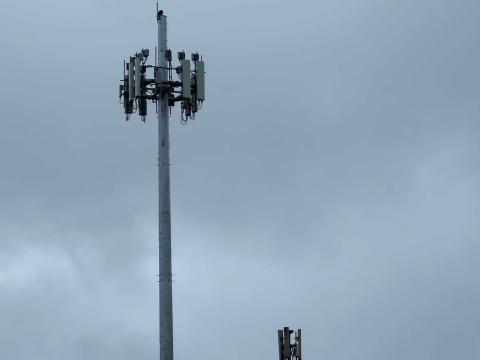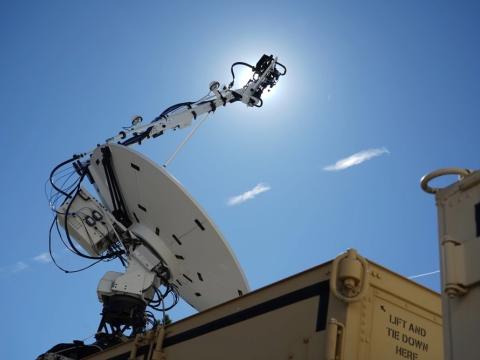System Ensures Munitions Hit Their Mark
 |
| The Pocket-sized Forward Entry Device (PFED) makes digital much of the work forward observers previously performed manually and with voice communications. The system runs Windows CE on a rugged personal digital assistant (PDA). |
Forward observers are trading in their pencils and voice communications systems for a more digitized approach to calling for fire. A handheld technology reduces the chance for human error, enhances accuracy and saves troops valuable time.
The Pocket-sized Forward Entry Device (PFED) currently is morphing into its third version since its initial rollout in 2000. Its success with
PFED runs Windows CE and uses Single Channel Ground and Airborne Radio System Advanced System Improvement Program (SINCGARS ASIP) communications. The system interoperates fully with the Advanced Field Artillery Tactical Data System (AFATDS) and current fire support systems. PFED integrates military lasers, radios, wireless and satellite communications, and GPS technology to send secure and precise target information from the front line up the chain of command. In addition to operating with SINCGARS ASIP radios, PFED works with satellite communications radios, high frequency radios and others.
Before PFED was developed, forward observers used binoculars and maps to determine target coordinates, performing calculations by hand then relaying those coordinates by radio using voice communications through the chain. Information was passed through several people, and opportunities for miscommunication existed at each juncture despite checks and balances put in place to reduce error. PFED relays the information digitally and automatically. “PFED is the first-line digital entry device in the fire support chain,” explains Jeffrey Weiss, product director, Handheld Systems, Office of the Project Manager for Battle Command,
PFED obtains information directly from the laser range finder and performs calculations automatically. It generates digital messages, which are sent to the Fire Support Team level, eliminating human error. By sending information digitally, warfighters can avoid mistakes due to transposed characters and forgotten information. The personnel at the Fire Support Team level determine whether to engage a target. If they choose to engage, they send the order to the
The forward observers enter the information they obtain into the PDA device, such as the number of tanks, movement of people, vehicles or weapons, or whether a target is an enemy or a friend. “Not everything is crush, kill and destroy,” Weiss states.
According to Peter Cannito, program manager for PFED, Booz Allen Hamilton,
Booz Allen develops the software as a service to the government as opposed to organizations that develop the product and sell to government agencies as licensees. PFED is developed as a partnership between the private company and the government, and the government has access to all the software code.
In addition to improving accuracy, PFED also shortens the time it takes to relay orders. Instead of a forward observer having to perform calculations, relay information and then wait for verification to be read back, the message is sent from device to device. This digitization makes troops less detectable by reducing radio frequency signatures, and PDAs release fewer emissions than do laptops. Digitization also frees up the network faster because data is transmitted more quickly. “You want to say your piece and get off the network and let someone else have a shot at it,” Weiss states.
Weiss also says that despite PFED’s advantages, many troops still resort to voice communications, especially in missions with short time lines. His team works to demonstrate the efficiencies of the advanced technology. “One challenge is showing them how much better it is to go digital,” Weiss says. “It’s a training issue.”
As troops become more familiar with PFED, they are more likely to use it, and system developers are making the latest version of the device as user-friendly as possible. Younger generations of soldiers and Marines who grew up with video games and other electronic equipment are more receptive to using the system, according to Weiss.
The first version of PFED included the basic tools necessary for forward observers to carry out their mission. In the second version, developers integrated a GPS capability and increased the number of other systems with which the device could interface.
The second version of PFED contained an updated messaging format as well as new functionalities such as an enhanced laser range finder interface and the capability to calculate targets more robustly based on the world magnetic model for calculating magnetic variance. This version received increased processing speeds as well. According to Tom Roe, project manager for PFED, Booz Allen Hamilton, most of the changes were based on input from U.S. Marine Corps users. Also in version two, Booz Allen incorporated the U.S. Army’s AN/PSN-11 precision lightweight GPS receiver (PLGR) and the Marine Corps’ AN/PSN-13 defense advanced GPS receiver. The integrated GPS reduces the total weight and footprint and eliminates the need for cable.
 |
| U.S. soldiers and Marines are using PFED to improve forward observer activities. Other service branches are interested in the system, but experts say no one platform will meet the needs of all the services. |
The third version also will integrate a new type of weapon. “Probably the biggest thing we’re adding is support for precision guided munitions,” Weiss says. “That’s a real big push these days.” Since precision guided munitions are designed to hit exactly where coordinates direct, imprecise orders result in missed targets. The cost of these weapons, along with major concerns about collateral damage especially in many of the urban combat battlefields that
GPS provides good results, but factors such as lasers, steadiness and terrain can affect its accuracy. Developers are modifying the PFED software to use precise imagery and precise coordinates to send precise munitions.
PFED’s third version will incorporate a new functionality to allow personnel at the Fire Support Team level to use the system. The Fire Support Team will use the PFED software on a handheld computer that is much larger than the PFED PDA. The fire support PFED will have the capabilities required for operations at this level, as well as programmed authorizations. According to Roe, Fire Support Team mode includes additional options for message processing. And PFED version three includes fire support coordination capability at the Fire Support Team level. This technology enables warfighters to check against certain coordination measures, such as zones and firing lines that determine whether certain missions can be conducted in specific areas. Using PFED, Fire Support Team personnel can alert forward observers in the event that they are about to engage a target in a location such as a no fire zone. Fire Support Team personnel will receive messages from forward observers’ PFEDs to their own and relay the messages to the
PFED was designed with current operations and future uses in mind. “You want to field a capability that [troops] can use at that point and then improve upon it, and that’s the approach we took,” Weiss explains. The system includes Bluetooth technology, although current policies prohibit the technology’s use. When procedures are put in place for wireless operations, PFED will provide users the capability to set up a personal area network in which the device will be able to communicate with the forward observers’ laser range finders without a wire connection.
To improve PFED operation, developers are determining how to maximize screen space, including creating a map that fits into the screen. The small display has limitations in what it can provide, but Weiss explains that forward observers need to view their area of interest, not an entire battlefield.
According to Weiss, the systems are not intended to be flashy but to work well and assist warfighters in their missions. The goal, he says, is to provide the necessary capabilities to the troops while being a good steward of taxpayer money by using commercial off-the-shelf technology. “We’re trying to support the taxpayer and obviously the soldier and not cut either one of them short,” he adds. The relatively low cost also means the systems can be replaced more easily and quickly than larger, more expensive devices.
PFED benefits warfighters through a less technical, but still critical, factor—its size. Forward observers and light infantry units carry many pounds and pieces of equipment. “We had old forward observer devices that were six, seven, eight pounds,” Weiss explains. Most of those troops would rather carry extra food or more ammunition, he adds.
Weiss’ office is handling two programs that use the same hardware as PFED—Centaur and the Gun Display Unit Replacement (GDU-R). Centaur is a lightweight technical fire direction system that computes ballistics. The GDU-R displays various information needed by gun crews. The crews read and base their firings on the information. By sharing information with organizations that are performing similar work, developers are able to field programs faster and avoid duplicating effort.
Other military branches are interested in the PFED technology, and the services are working together to develop an interoperable system to share information among troops. However, according to Weiss, no one platform will meet everyone’s requirements. The U.S. Air Force, for instance, would have less difficulty handling a 15-pound box, because it mounts the system in aircraft, than would Army or Marine Corps ground troops who have to haul the weight on foot.
The Army is still fielding PFED based on a master deployment list with priority status given to deployed units. The technology has applications to other government missions including search and rescue operations, unit status reports and medical evacuations.
Web Resources
Project Manager Battle Command Fire Support: http://pmatccs.monmouth.army.mil/bc_Fire_Support.html
Booz Allen Hamilton PFED: www.boozallen.com/capabilities/Industries/industries_article/11713104




Comments